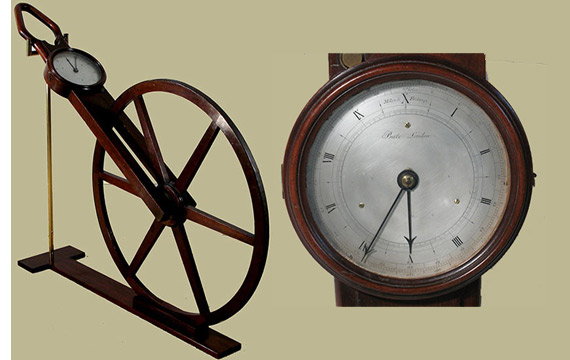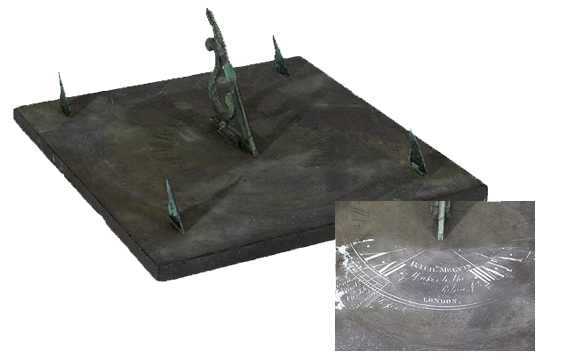|
|
|
271-275 of 930 items | view by date |
|
|
|
 |
 |
 |
Early 19th century mahogany "waywiser," a surveyor's measuring device
Surveyors today use a waywiser (also known as an odometer or a perambulator) to measure linear distances on the ground. This elegant English example in mahogany dates from the early 19th century, and the dial measures in yards (the longer of the two hands), poles (an antiquated term interchangeable with rods, 16.5 feet, 320 poles per mile), furlongs (220 yards), and miles. The iron-rimmed wheel is...
|
 |
 |
 |
 |
 |
Mid-19th century slate sundial with five gnomons by Richard Melville (aka Melvin), Crystal Palace, London
This is a most interesting sundial, utilizing a central gnomon of 50 degrees 51 minutes north for London, and four corresponding smaller gnomons for a "World Time" display in the corners. The corner dials are engraved with New York, Morning (five hours earlier), Alexandria, Egypt,
Afternoon (two hours later), Island of Borneo, Evening (seven hours later), and New Zealand, Night (12 hours later). ...
|
 |
 |
 |
 |
 |
Large Regency period English vernier octant by Joseph Gaitskill, London
The name octant derives from the Latin octans meaning eighth part of a circle, referring to the angle of 45 degrees between the arms of the frame. The ivory scale is divided into 90 degrees, or one fourth of a circle. John Hadley (1682-1744) described an instrument of this sort to the Royal Society of London in 1731 and obtained a British patent in 1734. Accordingly, octants are sometimes known ...
|
 |
 |
 |
 |
 |
19th century ship's barometer by Spencer, Browning & Co., London
Spencer, Browning & Co. is one of the most recognized names in the 19th century production of instruments in general, and barometers in particular. This is a good and clean example, with a mahogany case and brass frames for the register plates and thermometer. Register and thermometer plates are engraved ivory. The thermometer is graduated in Fahrenheit and centigrade, with Fever Heat marked at 11...
|
 |
 |
|
|
|
Antiques and Fine Art is the leading site for antique collectors, designers, and enthusiasts of art and antiques. Featuring outstanding inventory for sale from top antiques & art dealers, educational articles on fine and decorative arts, and a calendar listing upcoming antiques shows and fairs.
|